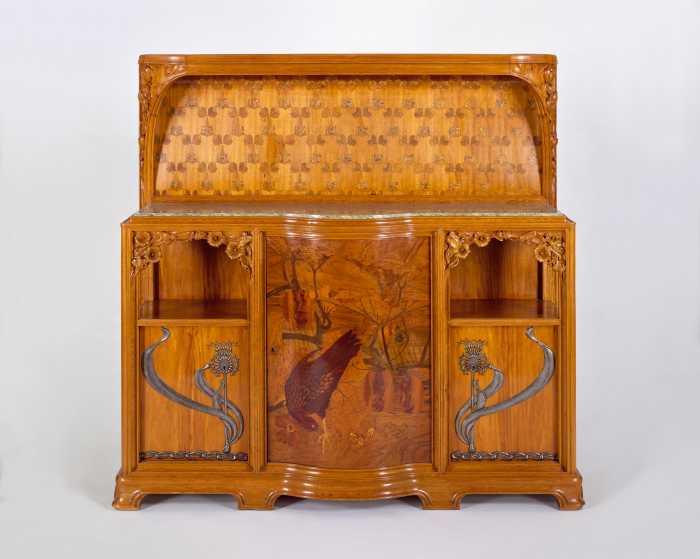In America, a few eyebrows may still rise
at the sight of a major art institution turning its attention
to cartoons. But the West’s growing recognition of "anime,"
Japanese animation, is currently much in evidence at the Brooklyn
Museum of Art.
For the August edition of their monthly First Saturday event,
the Museum on Aug. 4 will screen the 1992 anime gem "Porco
Rosso" ("The Crimson Pig") and offer a lecture
tour of the newly opened exhibition, "My Reality: Contemporary
Art and the Culture of Japanese Animation."
"Serious and fun," is how Brooklyn Museum curator Charlotta
Kotik describes the exhibition, which is making its first stop
on a national tour after originating at the Des Moines Arts Center
in Iowa. "There are serious issues touched upon, in a guise
of playfulness."
The description could just as well apply to anime itself. In
Japan, animation is not ghettoized as children’s fare or locked
into one or two simplistic formulas. It aims at all ages, crosses
many genres and styles, and delves frankly into profound themes,
particularly those relating to technology and to gender roles.
With the line between popular culture and "high art"
increasingly blurred, the exhibition’s 17 Japanese and Western
artists find the images of anime a natural way to explore these
themes.
Revered animator Hayao Miyazaki’s "Porco Rosso" – about
a heroic flying ace cursed with the head of a hog – is a surprising
fit with "My Reality." Typical of Miyazaki’s work,
it is rather atypical of Japanese animation. The form is best
known for futuristic, usually Japanese and often post-apocalyptic,
settings, but "Porco" takes place in an idealized post-World
War I Italy. And while much of anime is controversial for its
use of nihilistic gore and sexual content, "Porco"
is warm and humane, even in its treatment of villains – easily
appropriate for any child who can read subtitles.
But in subtle ways, "Porco" alternately echoes and
critiques the same prototypical anime elements that the exhibition
does. Sculptor Kenji Yanobe encapsulates anime’s ambivalent fascination
with technology in his "Survival Racing Car, Yellow"
an eerie contraption intended for travel in nuclear winter and
resembling a hybrid of a go-cart and an old-fashioned diving
suit.
It could almost have rolled out of one of Miyazaki’s films, which
are full of the neo-quaint machines he loves to design. Most
of the elaborate 1920s planes in "Porco" are Miyazaki’s
reworked versions of actual craft, portrayed with painstaking
detail. In contrast to Yanobe’s sardonic vision, these romanticized
war machines hark back to an age before other planes dropped
the atom bombs that still haunt anime and, of course, all of
Japanese culture.
The specter of the natural world, especially the human body transformed
and malformed is a related fear/fascination. Takashi Murakami’s
sculpture "DOB in the Strange Forest" features, says
curator Kotik, "objects like flowers and mushrooms that
are very cute and very beautiful but kind of genetically altered.
They are very unreal and in that, they are a little scary."
Miyazaki’s half-animal hero puts a different, pre-nuclear age
spin on transformation. Porco’s barnyard affliction seems vaguely
magical, rather than technological, and grows out of unspoken
inner turmoil. It is mutation as a personal issue, rather than
a grand disaster like the genetic or radioactive mutations of
science fiction.
Speaking of mutated bodies, the artists also find plenty of food
for thought in Japanese animation’s single most recognizable
icons, its abundant super-vixens. These (often teenage) characters
are highly sexualized, with Lara Croft bodies and absurdly huge,
"cute" eyes. They can be powerful action heroines,
but on a moment’s notice may find themselves indecently assaulted
by tentacled aliens.
Miltos Manetas is one of the artists who addresses these mixed
messages, as in her video piece, "Flames 1."
"A video game, actually," says Kotik. "The heroine
is very strong and very beautiful and very young, so I could
see it as a tribute to the woman warrior and femininity. But
then there is a moment where, even after she wins, she kind of
says, ’I am sorry.’"
Miyazaki rarely resorts to this type of irony, but subverts the
stereotype through his affectionately drawn adolescent tomboys
– courageous heroines who are still normal girls. Redheaded Fio
in "Porco" is just one example, a gutsy teenager who
comes to the hero’s aid with her natural gift for aircraft design.
The super-vixen, in turn, is an offshoot of anime’s general predilection
for what Kotik terms, simply, "cuteness." Momoyo Torimitsu
critiques the extremes of this tendency, with two huge, brightly
colored bunnies that crouch over the visitor in an aggressively
adorable display. Even the most saccharine of viewers may agree
with the piece’s title, "Somehow I Don’t Feel So Comfortable."
Despite the family-safe warmth characterizing most of his films,
Miyazaki himself has expressed discomfort with the cuteness embodied
in so much animation. In "Porco Rosso" especially,
he carefully balances it with a sober style, a texture of the
everyday, and bittersweet emotions that may fly over kids’ heads
only to connect with their parents. (One fan calls this the Miyazaki
film "that most resonates within my middle-aged, war-torn,
lovelorn heart.")
The approach is an implicit rebuke to the eager-to-please sugar
high of, oh, say, recent Disney blockbusters. And it’s another
clue, among many, that museum visitors have stepped into an alternate
reality more complex than they had previously imagined.
Hayao Miyazaki’s "Porco Rosso"
(1992) screens at 7 pm on Aug. 4 at the Brooklyn Museum of Art
(Eastern Parkway at Washington Avenue). Admission is free from
5 pm to 11 pm on Aug. 4. Curator tour of the exhibition, "My
Reality: Contemporary Art and the Culture of Japanese Animation,"
begins at 7:30 pm. The exhibit runs July 28-Oct. 7. For more
information, call (718) 638-5000 or visit www.brooklynart.org
on the Web. For more information on Miyazaki’s films, visit www.nausicaa.net.

























